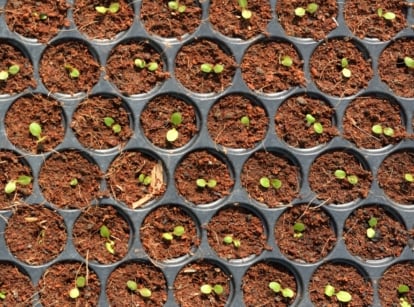
Can You Use Potting Soil to Start Seeds?
You might be wondering if it's okay to grab that leftover potting mix from last season to get seeds going. In this article, gardening expert Melissa Strauss explores the use of potting soil for seed starting.

You might be wondering if it's okay to grab that leftover potting mix from last season to get seeds going. In this article, gardening expert Melissa Strauss explores the use of potting soil for seed starting.

Peat-free soil mixes are becoming more readily available to improve soil health and lessen dependence on a renewable resource. Garden expert Katherine Rowe explores reasons to look for peat-free alternatives to incorporate in seeding, containers, and beds this growing season.

For success with soil blocking, a nutritive potting mix suited to the seed-starting method is essential. With a few ingredients, making your own mix goes a long way, using materials that have multiple garden applications. Join gardening expert Katherine Rowe in exploring core ingredients and rich variations to boost soil-blocked seedlings this season.

Soil blocking is a rewarding, hands-on way to promote healthy seedlings while reducing material use and saving space. If you’re interested in this historic way of seed-starting, we’ve got the essentials covered. Gardening expert Katherine Rowe explores everything you need to start soil blocking this season.

Winter frost doesn’t mean you have to quit composting! You can use some simple methods to get a pile working through the cold months. Learn how to compost in winter with these seven expert tips from native plant gardener Jerad Bryant.

Want to get ahead of the busy spring gardening season? Then start with soil prep! Farmer Briana Yablonski shares seven ways you can get your soil ready for spring right now.

November signals the end of fall and the beginning of winter. Although the garden is quiet, there are some things you can do to help your garden soil’s fertility and structure. Try one of these five easy methods alongside native plant gardener Jerad Bryant.

Now that the major growing season is coming to a close, your mind may be on cleaning up the garden, processing your last harvests, and raking up all the leaves. However, fall is also an excellent time to test your soil. This will give you plenty of time to make any adjustments needed before next year, balancing the nutrients and the pH level. Plant biologist Emily Estep will give you nine reasons why.

Improving your soil is always a good use of time! It helps future plant species gain all the nutrients, moisture, and air they need to survive. It also boosts beneficial fungi, bacteria, and archaea belowground. Join native plant gardener Jerad Bryant and discover nine easy ways to amend your garden’s soil.

Autumn is an ideal time to amend soils. Why? Soil amendments decay during fall and winter to form fertile, rich, crumbly soils in spring. You’ll have plantable beds ready for vegetables, wildflowers, and fruits. Join native plant gardener Jerad Bryant and learn the benefits of applying improvements now rather than in the spring.

Autumn is the ideal time to add soil improvements. They’ll start to break down this season and continue working slowly during the cool months. In spring, you’ll enjoy fresh, crumbly dirt that’s prime and ready for new seedlings! Join native plant gardener Jerad Bryant to see the 13 fall soil amendments you should add today.

Fall leaves are a nutrient-rich soil amendment, but do they make good compost? They do, but they’ll need extra care to morph into rich, crumbly soil. Learn how to turn fall leaves into beneficial compost with backyard composter Jerad Bryant.